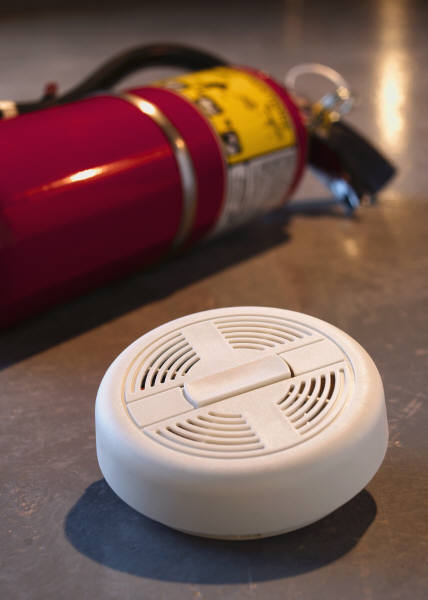Fire Prevention Week is October 8-14, 2023

DID YOU KNOW - Cooking fires are the leading cause of home fires and home fire injuries. Unattended cooking is the leading cause of cooking fires and deaths.
Tips for cooking safely:
- keep kids and pets at least 3 feet away from hot stoves/ovens
- stay in the kitchen while using the stove
- turn off the stove and oven if you must leave the kitchen
- when using the oven, set a timer to remind you to check your food
- keep anything combustible — e.g. oven mitts, paper towel, packaging, etc. — away from the stovetop
Visit https://www.nfpa.org/FPW for more information.
Fire prevention is everyone’s responsibility.
- Do your home and workplace have working Smoke Detectors?
- Do your home and workplace have a working Fire Extinguisher?
- Do you know your fire escape route?
Top 5 Fire Prevention Tips
- Use electricity safely: replace damaged cords and keep appliances in good repair
- Cook safely: never leave cooking unattended and keep cooking areas clean and tidy
- Keep matches and lighters out of sight: in the hands of a child, matches and lighters can be deadly. Store them out of children’s reach.
- Smokers use extra care: never smoke in bed or leave smoking cigarettes unattended
- Space heaters need space: keep portable heaters at least 3 feet from anything that can burn and ensure fuel fired space heaters have a good supply of fresh air
Top 5 Fire Safety Tips
- Install smoke alarms: every floor of your home and every bedroom should have smoke alarms
- Install automatic fire sprinklers: extinguish fires in less time than it takes for the fire department to arrive
- Plan your escape: make an escape plan and hold fire drills so everyone knows what to do
- Crawl low under smoke: in a fire, stay low. Check doors – if they feel warm, find another route
- Stop, drop and roll: if your clothing catches fire don’t run ... stop, drop and roll. Cool burns with clean water and call for help.
Wildfires
The risk of a significant wildfire in a west coast urban area like Colwood is low.
While there may be occasional small bush and grass fires, Colwood does not experience the same fuel loading, weather conditions, or fire behaviour that may happen in other parts of the province. For example, the Northern Peace region and the Central Interior experience extended periods of prolonged drought and high temperatures, coupled with vast forested areas and grasslands that severely affect the onset of wild fire conditions. Vancouver Island and more specifically Colwood do not experience these extreme factors as in other parts of the province.
The Colwood Fire department works with the Public Works department to identify and mitigate all potential fire risks using a natural forest approach where tree falls and other debris rot in place to maintain soil moisture and preserve tree health.
This Home Owners FireSmart Manual may provide useful information to Colwood home owners about general fire risks for properties. (This document was developed in Alberta where the risk of wildfire is much greater due to its large open areas of forest and undeveloped pasture land. It was adopted by BC, mainly for rural areas in the Peace River and Central Interior.)
Safety Recalls
Kiddie fire extinguishers with plastic handles - contact www.kiddie.com
Kidde hard-wired smoke and combination smoke/carbon monoxide (CO) alarms - contact www.kiddie.com
Think a product you have purchased may cause a fire safety risk? Check Health Canada for information about consumer product safety, and find out about hazardous products that have been recalled on the Consumer Product Safety Commission website.
Fireworks
Fireworks present an extreme safety risk. The City of Colwood prohibits the possession, discharge and sale of fireworks. Anyone wishing to obtain a permit must apply to City Hall and produce a current safety course certificate from a local fireworks safety discharge course or higher pyrotechnical certification. More details can be found in Bylaw 891.
We encourage you to enjoy fireworks events put on by trained personnel, rather than use consumer fireworks. These public events decrease the very real risk of personal injury and property damage that may result from improper use of fireworks.
The dangers of fireworks
- Fireworks injure 8,000 children in North America each year and 20 of those will die
- The most frequent injuries are burns to the hands and face
- About 120 people will require hand and finger amputations annually
- Permanent blindness occurs in about one-third of eye injuries
- Permanent hearing loss in children is not uncommon
- In one year, about 51,000 fires resulted in $37 million in property damage in North America
- Five to 10 children are admitted to BC Children’s hospital with fireworks injuries each year
- A seemingly harmless sparkler can burn as hot as 982 C and will not extinguish when placed in water
- The World Health Organization has recommended a worldwide ban on fireworks manufacturing
- There are no manufacturing standards in North America
- Many fireworks are manufactured overseas with little or no quality control
Source: BC Children’s Hospital
Fireworks Safety Recommendations
- Never point or throw fireworks at anyone or anything.
- Never hold fireworks in your hand while lighting them.
- Never attempt to re-light or move fireworks that fail to go off.
Please follow these common sense precautions to reduce the risk of injury or damage from fireworks:
- Only those 18 years of older, with a permit, may possess or discharge fireworks
- Only low hazard fireworks are to be used by the general public.
- Firecrackers and bottle rockets are prohibited throughout Canada by federal regulation.
- Modification of fireworks is prohibited
- Choose a safe outdoor area for discharging fireworks: a bare area of ground away from buildings, overhead obstructions, trees, vehicles, dry grass and other flammables.
- A bucket or wheelbarrow filled with soil or sand makes a good secure base.
- Spectators should watch from a safe distance, at least 20 metres upwind.
- A stick should be used to light fireworks, rather than matches or a lighter.
- Either a garden hose or a large bucket of water or sand should be ready at the site.
- Duds should be left untouched for a minimum of 30 minutes.
- Dispose of spent firework casings in a container of water.



